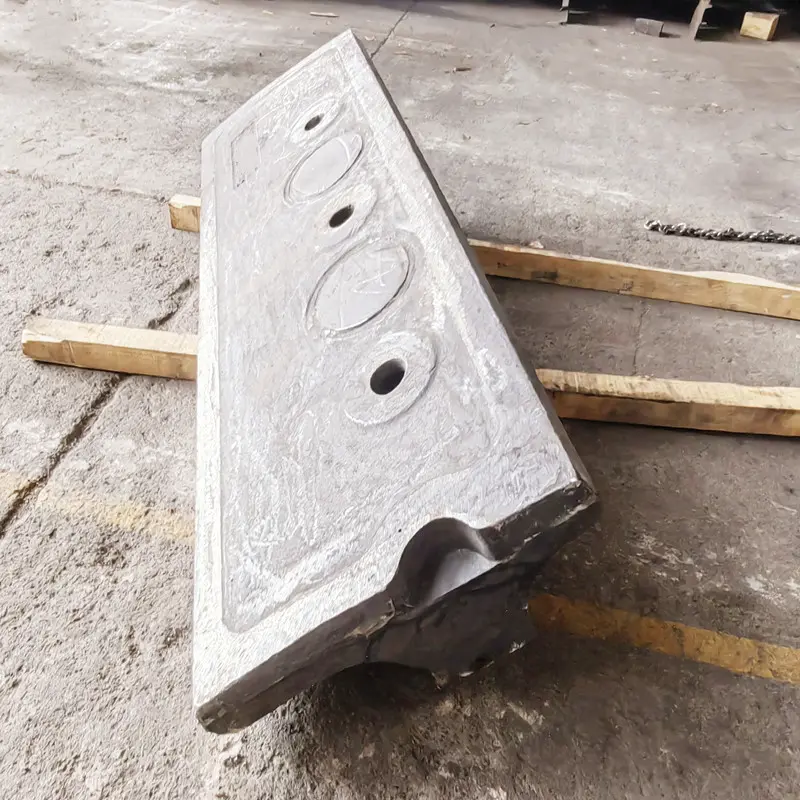In the field of mineral processing and mineral selection, the semi-autogenous grinding mill (SAG), as an efficient grinding equipment, is widely used in the processing of various ores. The shell liner of a semi-autogenous mill, especially the liner at the high feeding end, is crucial to the performance and service life of the equipment. This article will explore the design features, application advantages and maintenance points of the high feeding end of the semi-autogenous mill shell liner, helping you better understand and optimize this key component.
First. Design Features of the high feeding end of the semi-autogenous mill shell liner
1. Structural design
The design of the high feeding end of the semi-autogenous mill shell liner usually takes into account the feeding characteristics of the ore and the dynamic load during the grinding process. The liner plate at the high feeding end usually adopts a corrugated or stepped structure. This design helps to evenly distribute the ore and achieve effective grinding. Corrugated or stepped liners can increase the friction between the ore and the liners, promote the rolling and grinding of the ore, and thereby improve the grinding efficiency.
2. Material selection
The liner at the high feeding end needs to withstand the impact and wear of the ore, so the selection of materials is of vital importance. Generally, the liner plates at the high feeding end are made of materials such as high manganese steel, alloy steel or wear-resistant cast iron. These materials have excellent wear resistance and impact resistance, and can maintain a long service life under harsh working conditions.
3. Installation and fixation
The installation of the liner at the high feeding end needs to ensure its firmness and stability. The liners are usually fixed to the mill housing with bolts. During installation, it is necessary to ensure a tight fit between the liners to prevent leakage of the ore during the grinding process. In addition, during installation, the thermal expansion and contraction of the liner plate also need to be taken into account to avoid deformation or damage to the liner plate caused by temperature changes.
Second, the application advantage of the high feeding end of the semi-autogenous grinding machine shell liner
1.Improve grinding efficiency
The liner design at the high feeding end helps with the uniform distribution of the ore and effective grinding. Corrugated or stepped liners can increase the friction between the ore and the liners, promote the rolling and grinding of the ore, and thereby improve the grinding efficiency. This design can not only increase the processing capacity of ore, but also reduce energy consumption and improve the overall performance of the equipment.
2. Extend the service life of the liner
The liner plate at the high feeding end is made of wear-resistant materials and can maintain a long service life under harsh working conditions. By optimizing the structural design and material selection of the liner, the wear and damage of the liner can be effectively reduced, and the maintenance cost of the equipment can be lowered.
3. Reduce maintenance costs
The liner plate design at the high feeding end takes into account the convenience of maintenance. The installation and replacement of the liner are relatively simple, reducing maintenance time and labor intensity. In addition, the use of wear-resistant materials has also reduced the frequency of liner plate replacement, further lowering maintenance costs.
Third, key points for maintaining the high feeding end of the semi-autogenous grinding machine shell liner
1. Regular inspection
Regularly inspect the wear of the liner at the high feeding end and the tightness of the fixing bolts. Check whether the liner has cracks, wear or deformation. Discover and repair or replace the damaged liner in time to ensure the normal operation of the equipment.
2. Cleaning and lubrication
Keep the liner plate at the high feeding end clean and regularly remove the residual ore and impurities on the surface of the liner plate. At the same time, lubricate the fixed bolts to prevent them from loosening due to corrosion or wear.
3. Heat treatment and repair
For slightly worn or damaged liners, heat treatment or local repair methods can be adopted for treatment. Heat treatment can restore the hardness and wear resistance of the liner, and local repair can fix the cracks or worn areas on the surface of the liner, thereby extending the service life of the liner.
Fourth, Summary
The design and application of the high feeding end of the shell liner of the semi-autogenous mill are crucial to the performance and service life of the equipment. By optimizing the structural design of the liner, selecting appropriate materials and strengthening maintenance management, the grinding efficiency can be effectively improved, the service life of the liner can be prolonged and the maintenance cost can be reduced. It is hoped that the introduction in this article can help you better understand and optimize the design and application of the high feeding end of the semi-autogenous mill shell liner, providing strong support for your mineral processing and beneficiation work.
Post time: May-19-2025

